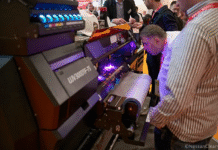Fujifilm has been innovative in offering imaging and print-related solutions. It has tried to step-up its focus each year, across all its product line-ups. Fujifilm offers workflow solutions, plates, CtP devices, wide-format inkjet printers, and biodegradable and lightweight corrugated boards for POP/POS. It also provides solutions for printing applications, including roll-to-roll and rigid media, from typical signage to billboards and retail signage.
In the 2019-2020 fiscal year ending 31 March, Fujifilm led in UV inkjet printing technology and even received a few patents for UV technology in the wide-format printing range. “The biggest reason why we have been able to implement new trends successfully is that our customers realize the fact that we are offering innovations at an affordable cost, that can help them achieve the ROI faster. In the last year, we witnessed significant growth in our UV printer installations with more than 135 installations. Our ink sales almost doubled in the last year. We are trying to create an ecosystem with wide-format UV printers. In the last fiscal year, we witnessed a 30% surge in the sale of UV printers, and we expect a similar trend this year,” says SM Ramprasad, head, Graphic Arts Business, Fujifilm India.
Effect of coronavirus on Fujifilm India
The novel coronavirus has posed not only a global health emergency but also an unprecedented global financial crisis. It has already started impacting businesses across categories, though it is too early to measure its ultimate impact. “However, we believe that industries such as packaging and pharma will continue to grow with a diverse mix of processes, products, and ancillary services for their customers. These are unusual times, and each stakeholder has a role to play individually in the most unselfish manner for the industry to keep growing. While it may take some time for the industry to bounce back after the current scenario, we hope that this kind of disturbance will lead to newer and different opportunities for us,” adds Ramprasad.
Observing the current developments led by the pandemic, Fuji India has decided to delay and rethink the product launches it already planned for this year. It is now modulating the road map for the year ahead and will debut new products after identifying a window of opportunity. “Due to the coronavirus outbreak, it was essential to take this step, especially with drupa being postponed. We support the decision taken by the organizers of drupa and look forward to creating a successful and impactful drupa in 2021 for Fujifilm and its customers,” says Ramprasad.
The delay in drupa will give many machine suppliers ample time to evaluate the products they want to unveil in April 2021. As far as Fujifilm, Ramprasad says that the company will display innovations in both the conventional as well as the digital printing space. To meet the adverse market conditions and customer expectations, the company will exhibit new inkjet technologies and also offer a glimpse of the future of automation at drupa 2021.
The Fujifilm JetPress digital sheetfed inkjet press
In 2018, Fujifilm launched the upgraded version of the 720S B2 digital sheetfed inkjet press, named Fujifilm JetPress 750S. The press is yet to be launched in India. “This press will give our customers high-quality short-run printing work at an affordable printing cost, and also complement their existing setup,” Ramprasad asserts.
The latest Jet Press 750S sheetfed press allows customers to optimize both the uptime for short-runs and medium runs of 5,000 sheets at 3,600 sheets an hour. Sheets with a maximum size of 750 x 585 mm can be run at 1200 x 1200 resolution.
The 750S model uses water-based food-grade inks, opening up the possibilities in printing and packaging for food and pharma industries. The machine can even print monocarton boxes on thick paperboard ranging between 80 to 300 grams per square meter. Additionally, it eliminates the spot colors and can obtain almost 83% of the Pantone colors with Fujifilm’s color processing feature in a 4-color press.
Fuji India’s new Bengaluru office
In February 2020, Fujifilm India opened its new office in Bengaluru. The new setup expands Fuji’s presence in southern India and serving its existing customers better and also providing a fun working environment to its workforce. With the new office, Fuji plans to increase its workforce by 30% in the city across its diverse offerings – electronic imaging, Instax, industrial products, graphic arts, and medical systems. The new setup took 70 days to complete. Fujifilm India currently has five offices located in Mumbai, Kolkata, Chennai, Bengaluru, with its head office in Gurugram.
Medical technology for controlling the Covid-19 outbreak
Fujifilm has pledged to contribute aid to medical workers in the Covid-19 crisis. “We have announced the supply of 200 N95 respiratory and surgical facemasks along with 40 PPE kits to healthcare professionals at the Post Graduate Institute of Medical Education & Research in Chandigarh. To combat the spread of the disease, we are providing these essential preventive healthcare utility (PPE) kits to doctors, which include surgeon’s gown, face mask, gloves, preventive eyewear, hood cap, and shoe cover.
“Additionally, we are installing computer radiology, digital radiology systems, and imagers across isolation wards to ensure effective monitoring and for controlling the outbreak. We believe that technology and innovation will work towards national service and play a vital role in these times of distress,” concludes Ramprasad.
















